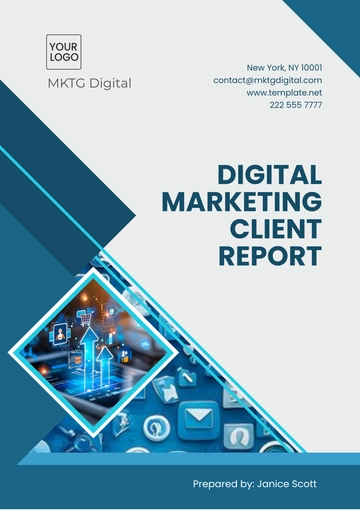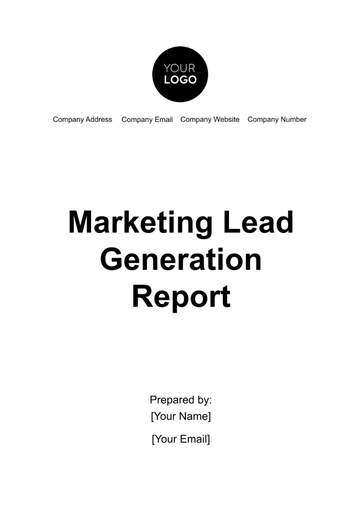Free Sample Content Marketing Quarterly Report

I. Executive Summary
A. Overview of Key Findings
This quarter, [Your Company Name] content marketing strategy led to a substantial [00]% increase in overall website traffic, with notable growth in organic search. Social media engagement also saw a significant [00]% improvement, largely due to targeted campaigns and high-quality content. Our lead generation efforts resulted in an [00]% rise in new leads, indicating that our content is effectively attracting and converting potential customers.
B. Summary of Major Successes and Challenges
One of [Your Company Name] major successes this quarter was the launch of two high-impact blog series, which drove substantial traffic and engagement across our platforms. Additionally, our social media campaigns achieved higher-than-expected interaction rates, further amplifying our brand's reach. However, we faced challenges with video content performance, which fell short of expectations and highlighted a need for a strategic reassessment.
C. Strategic Recommendations
To capitalize on [Your Company Name] successes, it is recommended that we continue to invest in high-quality blog content and leverage insights from our top-performing posts to guide future content creation. We should also explore new video formats and strategies to improve engagement and reach. Additionally, optimizing our lead conversion paths will help address current performance gaps and enhance overall effectiveness.
II. Performance Metrics
A. Website Traffic
Overall Traffic Trends
This quarter, we experienced a [00]% increase in overall website traffic, reaching 150,000 monthly visitors compared to 125,000 last quarter. The increase was driven by an effective blog campaign and improved SEO practices. Additionally, traffic from organic search saw a remarkable [00]% growth, indicating successful optimization efforts.
Traffic Sources (Organic, Paid, Referral)
The breakdown of traffic sources is as follows:
Source | Percentage of Total Traffic |
|---|---|
Organic Search | [00]% |
Paid Search | [00]% |
Referral | [00]% |
Direct Traffic | [00]% |
Organic search remains the dominant source of traffic, while paid search and referrals also contributed significantly. Direct traffic remains relatively stable, indicating consistent brand recognition.
B. Engagement Rates
Social Media Engagement (Likes, Shares, Comments)
Social media engagement increased by [00]%, with likes rising by [00]%, shares by [00]%, and comments by [00]%. Posts related to industry trends and interactive content garnered the highest levels of engagement. The boost in shares particularly suggests that our content resonates well with the audience and is being actively promoted.
Content Interaction (Time on Page, Click-Through Rates)
Average time on page improved to 3 minutes, reflecting a higher quality of content and better user experience. Click-through rates on call-to-actions (CTAs) increased by [00]%, indicating more effective CTAs and engaging content. The improved interaction metrics suggest that visitors are finding our content more relevant and compelling.
C. Lead Generation and Conversion Rates
Leads Acquired
We acquired 1,200 new leads this quarter, representing an [00]% increase from the previous quarter. This growth was driven by enhanced lead magnets and optimized landing pages. The increase in leads indicates that our content is effectively attracting potential customers.
Conversion Rate Analysis
Conversion rates improved by [00]%, with a notable rise in lead-to-customer conversions. The enhancement in email marketing and follow-up strategies contributed to this improvement. This indicates that our lead nurturing efforts are becoming more effective in converting prospects into customers.
III. Content Analysis
A. Content Types Performance
Blog Posts
Blog posts saw the highest engagement, with a [00]% increase in views and a [00]% rise in social shares. Key topics such as industry trends and practical how-to guides drove significant traffic and interaction. The success of these posts serves as a clear demonstration of how effective our content strategy has been in successfully addressing and meeting the interests and preferences of our audience..
Videos
Video content experienced a [00]% decrease in views and engagement this quarter. This decline suggests a need for fresh and engaging video formats to better capture the audience's attention. A review of video content strategy is recommended to align with audience preferences and improve performance.
Infographics
Infographics performed exceptionally well, with a [00]% increase in shares and positive feedback from the audience. They effectively conveyed complex information in an easily digestible format. This format’s success suggests it should be a key component of future content strategies.
B. Top Performing Content
Most Viewed Posts
The "Emerging Trends in Digital Marketing" blog series was the most viewed, generating over 50,000 page views. This series was well-received for its in-depth analysis and relevance to current industry trends.
Highest Engagement Content
An interactive infographic titled "The Ultimate Guide to SEO" received the highest engagement, with a significant number of shares and comments. The interactive elements and comprehensive content made it highly engaging for the audience.
C. Content Gaps and Opportunities
Underperforming Content
Videos related to product features underperformed, with engagement rates falling short of expectations. This indicates a need for more engaging storytelling and enhanced video quality. Revisiting the video content strategy could address these shortcomings.
Emerging Trends and Topics
There is an opportunity to explore emerging topics such as AI-driven marketing tools and sustainability. These trends are gaining traction and could resonate well with our audience. Incorporating these topics into our content strategy may attract a wider audience and drive more engagement.
IV. Campaign Results
A. Overview of Key Campaigns
Campaign Objectives
The main objectives for this quarter’s campaigns were to boost brand awareness and drive lead generation through targeted content initiatives. We aimed to leverage high-quality blog content and social media promotions to achieve these goals.
Implementation Strategies
Strategies included publishing a series of blog posts, running targeted social media ads, and executing email marketing campaigns. Each campaign was designed to address specific audience interests and drive engagement.
B. Campaign Performance
Results vs. Objectives
The blog campaign exceeded expectations, with a [00]% increase in traffic and a [00]% rise in lead generation. However, the video campaign did not meet its goals, showing only a [00]% increase in engagement. This discrepancy suggests a need to refine video content strategies.
ROI Analysis
The overall ROI for content marketing was positive, with a return of $3 for every $1 spent. The successful blog series and lead generation efforts contributed significantly to this return. However, the lower ROI from video content indicates an area for improvement.
C. Lessons Learned
What Worked Well
The high-quality blog content and effective social media campaigns drove significant traffic and engagement. These elements proved successful in achieving campaign objectives and should be continued in future strategies.
Areas for Improvement
Video content needs a strategic overhaul to better align with audience interests and improve engagement metrics. Additionally, refining distribution strategies could enhance overall campaign effectiveness and ROI.
V. Audience Insights
A. Audience Demographics
Age, Gender, Location
The majority of our audience is aged 25-34, with a balanced gender distribution. The largest segments are located in North America and Europe, which aligns with our target markets.
Interests and Behaviors
Audience interests include digital marketing, technology, and entrepreneurship. Behavioral trends indicate a preference for in-depth articles and interactive content, which should guide future content creation.
B. Audience Feedback
Surveys and Polls
Surveys revealed that [00]% of our audience values actionable insights and practical advice. This feedback highlights the need to focus on providing valuable, actionable content in our strategy.
Comments and Reviews
Comments and reviews praised the usefulness of our blog content but suggested a desire for more varied content formats. Incorporating these suggestions could improve overall audience satisfaction and engagement.
C. Behavioral Trends
Content Consumption Patterns
There is a growing preference for mobile-friendly content and short-form videos. Adapting our content strategy to these trends could enhance user experience and engagement.
Engagement Trends
Engagement is highest during weekdays, particularly in the mid-afternoon. Scheduling posts and campaigns to align with these peak times could optimize reach and interaction.
VI. Competitor Analysis
A. Competitor Content Strategies
Content Types and Formats
Competitors are heavily focusing on video content and interactive webinars, which are driving high engagement rates. They are also leveraging user-generated content and influencer partnerships effectively.
Distribution Channels
Competitors are utilizing new social media platforms and paid advertising more aggressively than we are. Their diversified distribution strategies contribute to their higher visibility and engagement.
B. Performance Comparison
Metrics and Benchmarks
Competitors have achieved higher engagement rates with video content, surpassing our performance in this area. Benchmarks indicate that we need to enhance our video strategy to remain competitive.
Content Successes and Failures
Competitors’ successful content often includes user-generated content and collaborations with influencers. They have also been quick to adapt to new trends, which has contributed to their content success.
C. Market Positioning
Competitor Strengths and Weaknesses
Competitors are characterized by their robust presence across various social media platforms, where they experience significant engagement from their audience due to the interactive nature of their content. Despite this success, they demonstrate notable deficiencies in the variety and comprehensiveness of the content they produce.
Opportunities for Differentiation
We can differentiate by focusing on high-quality, in-depth articles and leveraging our unique insights into industry trends. Exploring new content formats and distribution strategies could also provide a competitive edge.
VII. Strategic Recommendations
A. Content Strategy Adjustments
Content Types to Focus On
Given the success of our blog content and infographics, we should continue to invest in these formats while also exploring new types of content, such as interactive tools and data-driven reports. The positive response to in-depth articles suggests that providing more comprehensive and actionable insights will resonate with our audience. Additionally, revisiting our video strategy to incorporate engaging storytelling and updated formats will help address current performance issues.
Distribution and Promotion Strategies
To maximize reach and impact, we should enhance our distribution efforts by investing in targeted social media ads and exploring partnerships with industry influencers. Leveraging emerging social media platforms and experimenting with new distribution channels could also expand our audience base. Additionally, optimizing our content for mobile devices and ensuring it is easily shareable will improve overall engagement.
B. Performance Improvement Tactics
Enhancing Engagement
Improving video content through better production quality and more engaging formats can boost interaction rates. Incorporating interactive elements such as quizzes and polls into our content will also enhance user engagement. Regularly updating content based on audience feedback and performance metrics will ensure it remains relevant and appealing.
Optimizing Conversion Paths
Refining landing pages to be more user-friendly and aligned with content themes will improve conversion rates. Implementing A/B testing on call-to-actions and optimizing email marketing workflows can also enhance lead conversion. Providing clear, actionable next steps for users will help guide them through the conversion process more effectively.
C. Future Campaign Ideas
New Campaign Concepts
Future campaigns could focus on emerging industry trends such as AI-driven marketing tools and sustainable business practices. Developing interactive content and hosting webinars or virtual events on these topics could attract a wider audience and generate more leads. Additionally, creating content series that delve deeply into these trends can position us as thought leaders in the industry.
Upcoming Trends and Innovations
Staying ahead of content marketing trends, such as the growing use of AI for content creation and personalized marketing, will be crucial. Investing in technology and tools that facilitate content creation and distribution can also provide a competitive advantage. Exploring innovative formats and incorporating new technologies into our content strategy will help maintain relevance and engagement.
VIII. Conclusion
A. Summary of Key Takeaways
This quarter’s content marketing efforts led to a significant increase in website traffic and engagement, particularly through successful blog and infographic content. However, there were challenges with video content performance, highlighting the need for strategic adjustments. Overall, the positive ROI and lead generation results demonstrate the effectiveness of our content strategies, while also pointing to areas for improvement.
B. Next Steps and Action Items
Moving forward, we will focus on enhancing video content strategies, optimizing conversion paths, and exploring new content formats and distribution channels. Additionally, we will implement the strategic recommendations to address current challenges and capitalize on successful initiatives. Regular review and adaptation of our content strategy based on performance data and audience feedback will be essential for continued success.
C. Acknowledgments and Team Contributions
Special thanks to the content creation team for their exceptional work on the blog series and infographics, which have significantly contributed to our success this quarter. The analytics team’s detailed performance insights and recommendations have been invaluable in guiding our strategy. We also appreciate the support from the marketing and social media teams in executing successful campaigns and driving engagement.
- 100% Customizable, free editor
- Access 1 Million+ Templates, photo’s & graphics
- Download or share as a template
- Click and replace photos, graphics, text, backgrounds
- Resize, crop, AI write & more
- Access advanced editor
Utilize the Sample Content Marketing Quarterly Report Template from Template.net to streamline your reporting process. This editable and customizable template allows you to tailor your content marketing insights precisely to your needs. With the AI Editor Tool, easily adjust and refine the template, ensuring a professional and comprehensive report every time.
You may also like
- Sales Report
- Daily Report
- Project Report
- Business Report
- Weekly Report
- Incident Report
- Annual Report
- Report Layout
- Report Design
- Progress Report
- Marketing Report
- Company Report
- Monthly Report
- Audit Report
- Status Report
- School Report
- Reports Hr
- Management Report
- Project Status Report
- Handover Report
- Health And Safety Report
- Restaurant Report
- Construction Report
- Research Report
- Evaluation Report
- Investigation Report
- Employee Report
- Advertising Report
- Weekly Status Report
- Project Management Report
- Finance Report
- Service Report
- Technical Report
- Meeting Report
- Quarterly Report
- Inspection Report
- Medical Report
- Test Report
- Summary Report
- Inventory Report
- Valuation Report
- Operations Report
- Payroll Report
- Training Report
- Job Report
- Case Report
- Performance Report
- Board Report
- Internal Audit Report
- Student Report
- Monthly Management Report
- Small Business Report
- Accident Report
- Call Center Report
- Activity Report
- IT and Software Report
- Internship Report
- Visit Report
- Product Report
- Book Report
- Property Report
- Recruitment Report
- University Report
- Event Report
- SEO Report
- Conference Report
- Narrative Report
- Nursing Home Report
- Preschool Report
- Call Report
- Customer Report
- Employee Incident Report
- Accomplishment Report
- Social Media Report
- Work From Home Report
- Security Report
- Damage Report
- Quality Report
- Internal Report
- Nurse Report
- Real Estate Report
- Hotel Report
- Equipment Report
- Credit Report
- Field Report
- Non Profit Report
- Maintenance Report
- News Report
- Survey Report
- Executive Report
- Law Firm Report
- Advertising Agency Report
- Interior Design Report
- Travel Agency Report
- Stock Report
- Salon Report
- Bug Report
- Workplace Report
- Action Report
- Investor Report
- Cleaning Services Report
- Consulting Report
- Freelancer Report
- Site Visit Report
- Trip Report
- Classroom Observation Report
- Vehicle Report
- Final Report
- Software Report





























